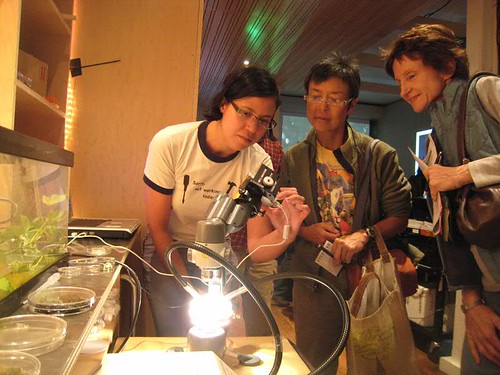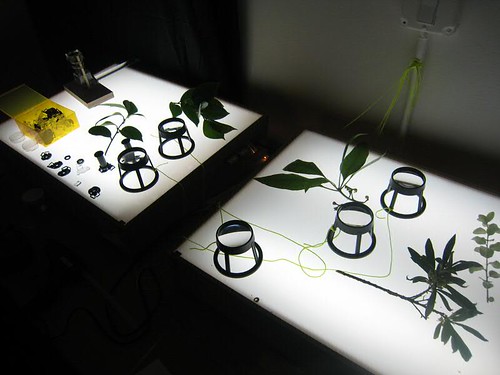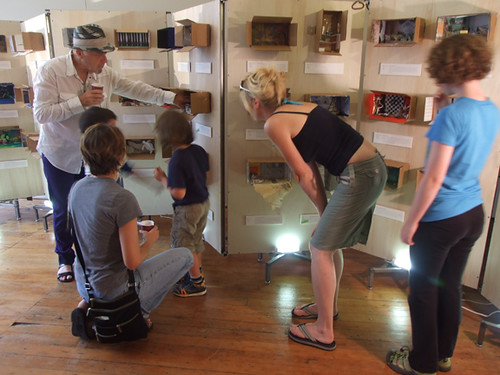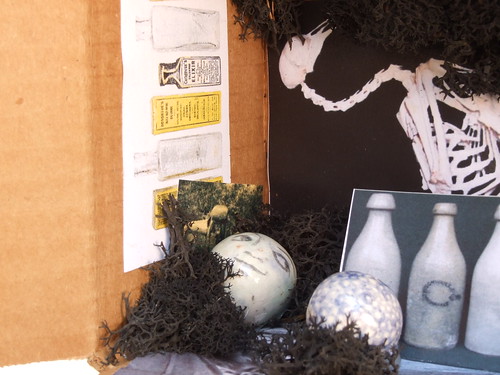
On Saturday October 24th CRITTER presented Eat Bug Eat!, an afternoon tasting of edible insect foods. We served wax moth larvae, meal worms, and ‘super’ worms in the form of gourmet tacos. It was so exciting to see people bravely try their first bug, and to watch their faces turn from apprehension to smiles when they realized how delicious they really are.

The bugs were dry fried in a pan, and presented on fresh tortillas with shredded jicamito, Salvadorian cream and some roasted tomatillo salsa verde. A pinch of sea salt and you’d never know you were eating something normally considered disgusting. After a while people started eating them right out of the bowl with salt and lime juice.

Rosanna Yau contributed some very yummy baked mushrooms stuffed with the above mentioned ‘super’ worms. We also had a few different kinds of mead for people to try. Mead is a wine made from honey, and we served it on ice to act as a foil for the fatty spicy crunch of the critters.

Phil Crumar was there singing and playing his guitar, adding to the atmosphere of bubbly excitement in the room. There is a huge hunger for more types of programs like this.
And, of course, there are more photos here.

 On September 12th from 6-9, CRITTER presented An Enormous Microscopic Evening, which mi
On September 12th from 6-9, CRITTER presented An Enormous Microscopic Evening, which mi ght best be described as a large microscope jam session. Microscopes are devices that skate on the edge of the fantastic, and the Bay Area is home to so many people who use this device for research, work or play.
ght best be described as a large microscope jam session. Microscopes are devices that skate on the edge of the fantastic, and the Bay Area is home to so many people who use this device for research, work or play.
On hand to present their instruments were The Exploratorium’s Living Systems Department, The Carnegie Institute for Science’s Department of Plant Biology, The Fletcher Lab from UC Berkeley, The SF Microscopical Society, the Merritt College Microscopy Program and Thomas Zimmerman.
It was an intense and interesting event, with people focused and talking for many hours at a time.
The scopes demonstrated throughout the evening spanned from home crafted devices made from recycled materials to state of the art immersive displays. More images here, here, and here.
From August 28 through August 30 CRITTER hosted The SF Mobile Museum at the Studto for Urban Projects.
This interactive exhibit on the Genius Loci of a place was conceived, produced and curated by Maria Mortati, and is a community sharing project between the citizens of San Francisco and Denver. Go to the SF Mobile Museum site for more information.
In this display were dioramas of meaningful locations made by the citizens of these two cities. Go here for more images of the show.
On the afternoon of July 25th CRITTER hosted the glorious Mark Allen of Machine Project fame, who came up from LA to lead a musical soldering workshop. Participants learned the basics of electronic circuit building by creating a primitive synthesizer while the band ing played music to solder by. As people got their synths working they joined ing in playing some simple repeating musical patterns. At the end of the workshop everyone played a simple and out of tune musical piece together.
Much mirth for all. And more photos here.

On Saturday April 18th Laura Allen from the Oakland-based Greywater Guerrillas came over to CRITTER and gave an inspiring presentation on easy ways to reduce the amount of water we use: Water catchments, super toilets and the amazing powers of pee! And, Earl Grey ice tea with beige cookies. Laura showed how the water in our lives is connected to local and global political and environmental issues, and how cities and counties are updating ancient techniques to conserve money and resources.
Laura showed how the water in our lives is connected to local and global political and environmental issues, and how cities and counties are updating ancient techniques to conserve money and resources.
 Greywater is water that flows down sinks, showers, and washing machine drains--but not the toilet. While greywater looks “dirty”, containing traces of dirt, food, grease, hair and household cleaning products, it is a safe and even beneficial source of water for plants. If released into rivers, lakes, or estuaries, greywater is considered a pollutant, but to garden plants it contains valuable fertilizer. Saving and reusing your greywater reduces water use by up to half, and can significantly reduce water bills. Greywater also reduces the material in the sewer or septic system, reducing the chance of overflow and pollution getting into local clean water.
Greywater is water that flows down sinks, showers, and washing machine drains--but not the toilet. While greywater looks “dirty”, containing traces of dirt, food, grease, hair and household cleaning products, it is a safe and even beneficial source of water for plants. If released into rivers, lakes, or estuaries, greywater is considered a pollutant, but to garden plants it contains valuable fertilizer. Saving and reusing your greywater reduces water use by up to half, and can significantly reduce water bills. Greywater also reduces the material in the sewer or septic system, reducing the chance of overflow and pollution getting into local clean water.
Some more images here.






 On September 12th from 6-9, CRITTER presented An Enormous Microscopic Evening, which mi
On September 12th from 6-9, CRITTER presented An Enormous Microscopic Evening, which mi

























